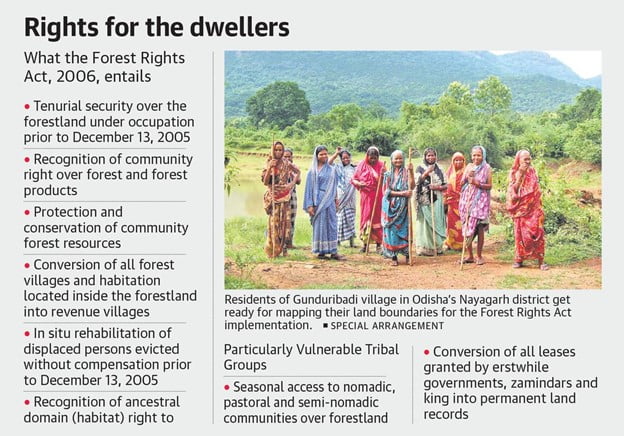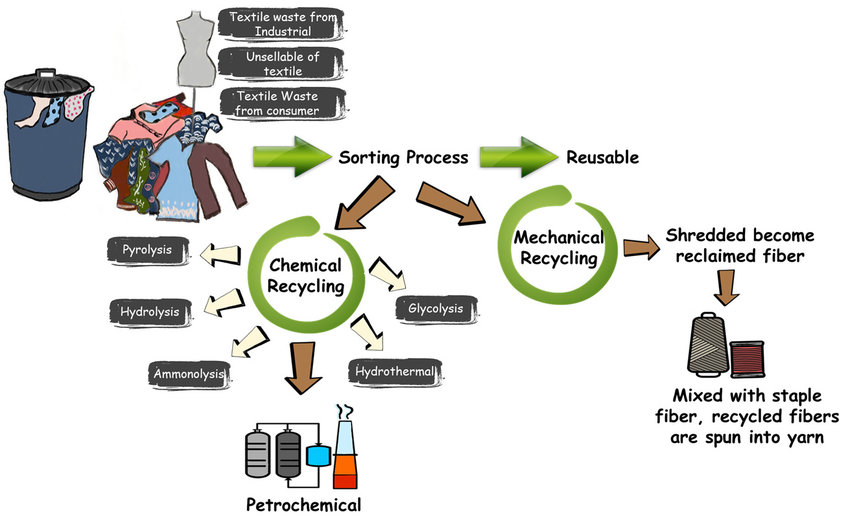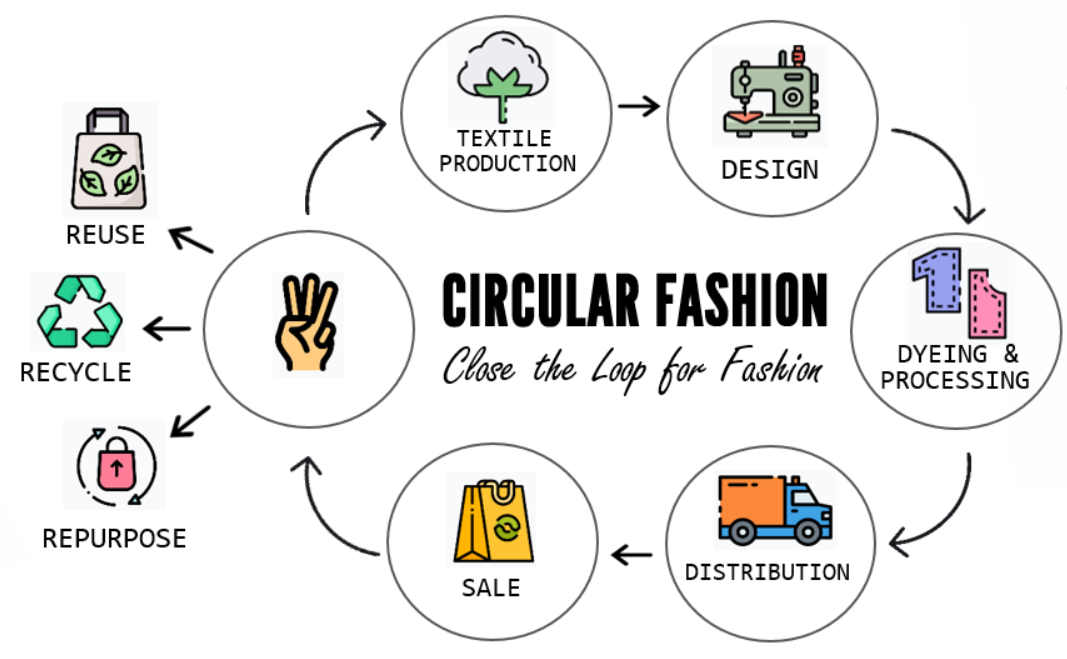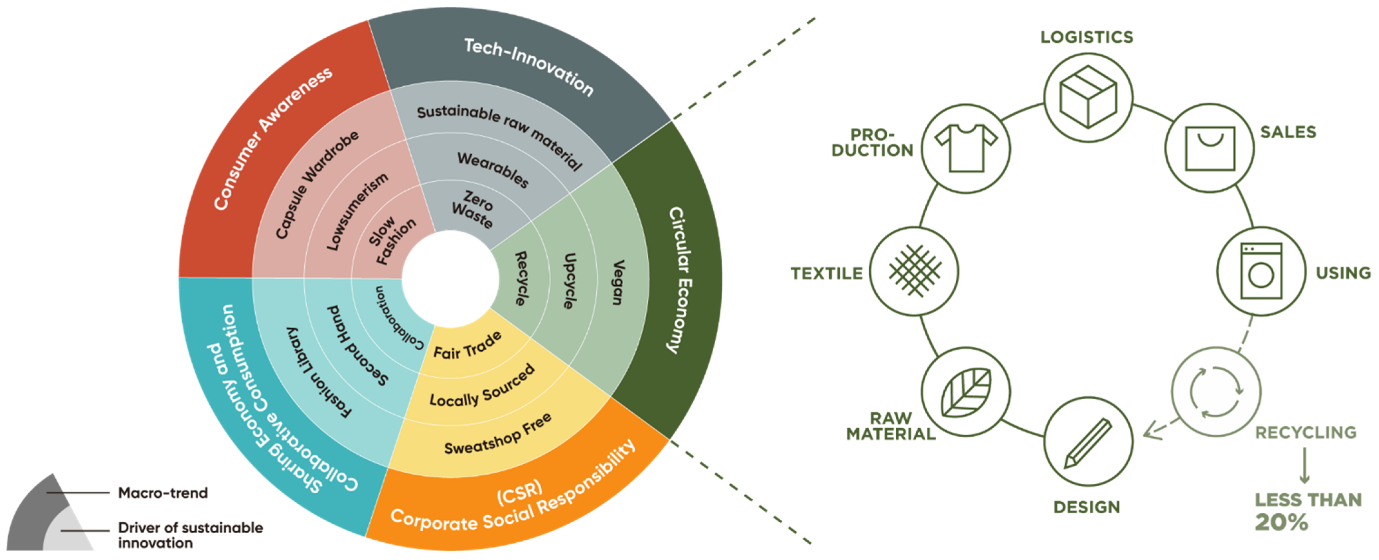|
|
||
|
15 February 2024 |
||
|
- Implications for the Rights of Forest-Dwellers
- Fashion Industry’s unsustainable recycling methods
- Horseshoe Crab: Living Fossils of the Sea
- Invasive Species: Cuscuta Dodder
- Launch of PM Surya Ghar: Muft Bijli Yojana
- Supreme Court bans Electoral Bond

Implications for the Rights of Forest-Dwellers

Context:
- Recent developments regarding the Thanthai Periyar Sanctuary in Tamil Nadu’s Erode district have sparked concerns among local forest-dwelling communities.
- These groups worry that the notification may infringe upon their rights as outlined in the Scheduled Tribes and Other Traditional Forest Dwellers (Recognition of Forest Rights) Act 2006 (FRA).
Implications of Sanctuary Notification on Rights and Livelihoods
- The recent notification regarding the Thanthai Periyar Sanctuary imposes restrictions on the traditional practices and livelihoods of forest-dwelling communities.
- Understanding the ramifications of these restrictions is essential in evaluating the sanctuary’s impact on the nearby populations.
Apprehensions of Forest Dwellers:
- Residents living near the Thanthai Periyar Sanctuary express concerns that the notification could jeopardize their established rights and customary activities.
- Their worries stem from historical injustices and the perceived inadequacies in implementing laws meant to safeguard their interests.
Exclusion of Tribal Forest Villages:
- The exclusion of six tribal forest villages from the sanctuary raises questions about equitable resource distribution and the recognition of indigenous communities’ rights.
- These settlements, covering an area of 3.42 sq. km, remain outside the sanctuary’s boundaries, depriving them of basic rights and amenities.
Conversion of Forest Villages and Land Use:
- The conversion of forest villages into revenue villages has been a contentious issue, with slow and incomplete progress despite directives from the Union Ministry of Environment and Forests (MoEF) and the FRA.
- This delay denies forest dwellers access to essential services and their ancestral lands.
Impact on Grazing Rights:
- The notification also restricts cattle-grazing activities, affecting the livelihoods of pastoralist communities and disrupting the ecological balance of the region.
- Native Bargur cattle, reliant on the Bargur forest hills for grazing, may encounter obstacles in accessing their traditional grounds.
Legal Framework and Enforcement:
- The Madras High Court’s ban on cattle grazing in forests, except for designated areas, highlights the tension between conservation efforts and traditional practices.
- Despite legal provisions recognizing the grazing rights of pastoralist communities, enforcement actions contradict these protections.
- A balanced approach considering conservation goals and livelihoods is necessary.
Challenges in Implementing the Forest Rights Act:
- Despite the enactment of the FRA in 2006 to address historical injustices, its implementation in Tamil Nadu has been sluggish.
- Minimal progress has been made in issuing individual and community titles, indicating systemic failures and bureaucratic obstacles.
Violation of Tribal Rights:
- Violations of tribal rights under the FRA persist due to the reluctance of state authorities to adhere to legal mandates and protect the rights of marginalized communities.
- Such violations are punishable under relevant laws but continue unabated.
Conflicting Legislations and Legal Framework:
- The conflict between the Wildlife (Protection) Act 1972 (WLPA) and the FRA underscores the need to harmonize conservation efforts with indigenous rights.
- While the WLPA aims to conserve wildlife, the FRA recognizes forest rights, necessitating a balanced approach.
Role of Gram Sabhas:
- Empowering gram sabhas to determine and recognize forest rights is crucial for community-based governance of natural resources.
- However, their effectiveness depends on state support and institutional capacity-building.
Historical Injustice and Legislative Reforms:
- The enactment of the FRA aimed to rectify historical injustices inflicted upon forest-dwelling communities by colonial-era policies.
- Recognizing indigenous rights and devolving decision-making authority to gram sabhas are essential steps toward empowering marginalized communities.
Conclusion:
Addressing the challenges posed by the Thanthai Periyar Sanctuary notification and the broader implementation issues of the Forest Rights Act requires a comprehensive approach.
Prioritizing equitable resource distribution, community participation, and legal reforms are essential to safeguarding the rights of marginalized populations.
- Fashion Industry’s unsustainable recycling methods
Introduction
- Numerous companies in the fashion industry, ranging from fast-fashion conglomerates to high-end brands, have incorporated recycled fabrics and eco-friendly messaging into their marketing strategies.
- However, a deeper examination reveals that these approaches often fail to yield significant environmental advantages.

Challenges in Fashion Industry Recycling
1. Greenhouse Gas Emissions:
- The use of polyester, a widely used fabric, contributes substantially to emissions.
- In 2016 alone, 28.2 million tonnes of polyester were utilized, emitting nearly three times the amount of CO2 compared to cotton.
- Additionally, nylon production generates nitrous oxide, a potent greenhouse gas, exacerbating climate change.
2. Water Intensity:
- The cultivation of cotton, crucial for clothing production, consumes vast quantities of water.
- Estimates suggest that up to 20,000 liters of water are required for producing a pair of jeans and a t-shirt.
- This escalating water consumption in clothing production could lead to potential water crises by 2030.
-

3. Water Pollution:
- Chemical dyeing, essential for creating vibrant textiles, stands as the second-largest polluter of clean water globally, introducing harmful substances into water bodies.
- Moreover, the heavy reliance on chemicals in cotton cultivation poses health risks and contributes to environmental degradation.
4. Plastics and Microfibers:
- Polyester clothing sheds microfibers during washing, contaminating oceans and threatening marine life.
- These non-biodegradable microfibers persist in the environment indefinitely, posing risks to human health and ecosystems.
5. Landfill Waste:
- The fashion industry is a significant contributor to landfill waste, with discarded clothing doubling over the past two decades due to fast fashion trends.
- The limited recycling of textiles exacerbates the landfill issue, with less than 1% of clothing material being reused.
6. Inability to Recycle:
- The complexity of fabric blends and the presence of non-biodegradable materials like polyester and nylon pose challenges to recycling technologies, hindering effective reuse.
- Moreover, China’s ban on recycled textile imports further complicates recycling efforts, limiting disposal options.
7. Economic and Ethical Considerations:
- Short-term profit incentives often take precedence over sustainability, leading to the perpetuation of greenwashing tactics and undermining genuine recycling efforts.
- Unethical labor practices exacerbate sustainability challenges, underscoring systemic issues in the fashion industry’s supply chain.
Methods for Recycling
Mechanical Recycling: This method breaks down textiles into fibers without altering their chemical composition, making it suitable for natural fibers like cotton.
Chemical Recycling: Textiles are broken down into basic chemical components, making this method ideal for synthetic fibers like polyester.
Steps involved: Both mechanical and chemical recycling methods entail sorting, shredding, cleaning, processing, and quality control to produce new fabrics or products, thereby reducing waste in the fashion industry.

Moving Towards True Sustainability
- Research and Development: Investment in innovative recycling technologies capable of processing complex fabric blends is essential.
- Transparency and Standards: Implementation of transparent supply chains and stringent recycling standards is necessary to ensure accountability.
- Consumer Education: Educating consumers about the true environmental and ethical impact of their clothing choices is crucial.
- Regulation and Accountability: Enforcing regulations and industry standards can hold fashion brands accountable for their sustainability commitments.
- Circular Economy Promotion: Embracing circular economy principles, such as extended producer responsibility and product lifecycle management, can minimize waste and resource consumption.

Conclusion
While recycling initiatives in the fashion industry offer some advantages, they are insufficient in addressing the sector’s overarching environmental and ethical challenges.
Achieving true sustainability requires systemic changes, including technological innovation, transparent practices, consumer awareness, regulatory enforcement, and promotion of circular economy principles. By embracing these principles, the fashion industry can work towards a genuinely sustainable and equitable future.
- Horseshoe Crab: Living Fossils of the Sea

Introduction
- Various environmental organizations have urged the U.S. government to extend endangered species protection to the American horseshoe crab.
- Known as “living fossils,” horseshoe crabs have persisted since before the era of dinosaurs.
About the Horseshoe Crab
- Habitat: They inhabit shallow coastal waters with soft sandy or muddy bottoms and typically spawn on intertidal beaches during high tides in the summer and spring seasons.
- Taxonomic Division: Belonging to the Chelicerata division of Arthropoda, which includes spiders, scorpions, harvestmen, mites, and ticks. They are characterized by a segmented body and limbs, as well as a chitinous exoskeleton.
- Status: Recognized as marine “living fossils” due to their minimal evolutionary changes over time.
- Geographic Range: The American horseshoe crab is found along the Eastern coast of the USA and in the Gulf of Mexico. Indo-Pacific species such as the Tri-spine, Coastal, and Mangrove horseshoe crabs are predominantly found in coastal waters of India, Southeast Asia, China, and Japan.
- Habitat in India: Odisha is identified as the primary habitat for horseshoe crabs in India.
- Conservation Status: Listed under Schedule IV of the Wildlife Protection Act of 1972 in India.
- IUCN Status: The American horseshoe crab is categorized as Vulnerable, while the Tri-spine horseshoe crab is classified as Endangered.
- Invasive Species: Cuscuta Dodder

Introduction
- The Chengalpet forests and Vedanthangal Bird Sanctuary are facing a grave threat from the encroachment of Cuscuta dodder, an invasive weed.
- This parasitic vine, originating from North America, has already infested extensive areas of trees within reserve forests and is beginning to spread within India’s oldest bird sanctuary.
- This poses significant risks to the local vegetation, ecology, and the habitat of migratory birds.
About Cuscuta Dodder
- Cuscuta dodder is a parasitic plant lacking roots, which operates by forming a dense canopy on its host plant and extending numerous tendrils.
- Over time, these tendrils form a thick mass, ultimately strangling and killing the host plant.
Persistence and Germination
- The seeds of Cuscuta dodder are round with a durable outer coating, allowing them to endure up to 50 years in dry storage and at least 10 years in the field.
- Unlike root parasites, these seeds do not require a specific stimulant to germinate, facilitating rapid spread.
Impact and Spread
- Cuscuta poses a significant challenge to various crops, including oilseeds, pulses, and fodder crops, across several Indian states such as Andhra Pradesh, Chhattisgarh, Gujarat, Orissa, West Bengal, and parts of Madhya Pradesh.
- Its impact is felt in both rain-fed and irrigated conditions. Globally, it is recognized as a ‘declared noxious weed’ in 25 countries, with stringent regulations on the movement of its seeds and plant material.
- In the United States, it is the only weed seed prohibited from movement in every state.
- Launch of PM Surya Ghar: Muft Bijli Yojana

Introduction
The Prime Minister recently unveiled the PM Surya Ghar: Muft Bijli Yojana with the aim of providing complimentary electricity to eligible recipients.
About PM Surya Ghar Muft Bijli Yojana
Description
The initiative seeks to offer 300 units of electricity free of charge each month to qualified individuals, with an investment totaling ₹75,000 crores.
Purpose
Originally introduced during an interim budget speech by the Finance Minister, the program is geared towards illuminating 1 crore households.
Target
Incentives for Renewable Energy
- To encourage the adoption of rooftop solar systems, urban local bodies and panchayats are being incentivized.
Financial Support
The Central Government pledges to alleviate financial burdens by providing subsidies directly to bank accounts and offering highly concessional bank loans.
Expected Benefits
- Households are anticipated to save between ₹15,000 to ₹18,000 annually.
- Facilitation of electric vehicle charging.
- Creation of entrepreneurial opportunities.
- Provision of employment prospects for technically skilled youth.
- Supreme Court bans Electoral Bond

Supreme Court’s Verdict
In a significant ruling, India’s Supreme Court has decided to ban electoral bonds, a contentious issue due to its opaque nature in funding elections.
Judicial Response to Petition
- The court’s decision follows an ongoing petition urging the elimination of electoral bonds.
- Concerns regarding their lack of transparency and potential for misuse, including money laundering, were previously voiced by the court in November.
Understanding Electoral Bonds
- Electoral bonds function as bearer instruments, similar to currency notes, with denominations ranging from 1,000 rupees to 10 million rupees.
- They are purchasable by individuals, groups, or corporate entities and can be donated to a chosen political party, redeemable without interest after a 15-day period.
Challenges Within the System
- A major issue with electoral bonds lies in the anonymity of donor identities.
- Unlike cash donations exceeding 20,000 rupees, which require disclosure, contributions made through electoral bonds remain undisclosed, regardless of the amount.
- This anonymity has made electoral bonds the primary method of political funding, constituting 56% of all political financing in India.
Critique of Electoral Bonds
- Critics argue that the anonymity associated with electoral bonds undermines democratic principles and fosters a climate ripe for corruption.
- By allowing unlimited, undisclosed contributions from any source, electoral bonds effectively institutionalize a form of legalized corruption.


